Description

Copyright infringement not intended
Context: The environmental price for switching to electric vehicles may be too heavy, according to a new report. The good for the global climate may be disastrous South America’s ecosystems.
Details:
- Some of the world’s rarest and most precious ecosystems — salt flats, wetlands, grazing pastures and flamingo lakes — high in the Andean mountains are at risk, said the report published in American online magazine Yale Environment 360.
- This remote region straddling the borders between Argentina, Bolivia and Chile has come to be known as the Lithium Triangle.


The Lithium Triangle region. Source: Yale Environment 360
- Lithium-ion batteries power electric cars and small electronic items.
- These have a higher energy density than typical lead-acid or nickel-cadmium rechargeable batteries. This means that battery manufacturers can save space, reducing the overall size of the battery pack, according to EDF, an electric utilities company.
- There’s a sudden focus on lithium in the global rush to decarbonise the world’s automobiles, the Yale report said.
- Demand for lithium is predicted to quadruple by 2030 to 2.4 million metric tons annually and in anticipation, prices on world markets have risen close to tenfold in the past year, it claimed.
- Lithium carbonate jumped to a new record September 16, 2022 to 500,500 yuan ($71,315) a ton in China, according to a report in Mining.
- The battery material has roughly tripled in the past year and is more than 1,150 per cent higher than a pandemic low touched in July 2020. Prices of lithium hydroxide are also gaining and closing in on an all-time high set in April, the report added.
- More than half of the world’s lithium reserves, or 56 per cent, are dissolved in ancient underground water within the Lithium Triangle, according to United States Geological Survey.
- Global consumption of lithium in 2021 was estimated to be 93,000 tons, a 33 per cent increase from 70,000 tons in 2020.
- Global mining conglomerates are competing to grab the metal by pumping that water to the surface and evaporating it in the sun to concentrate its lithium carbonate, the Yale report said.
- But every ton of lithium carbonate extracted from underground using this cheap, low-tech method typically dissipates half a million gallons of water into the air. This water is vital to the arid High Andes.
- The extraction lowers water tables. As freshwater often sits on top of salty water, this has the potential to dry up the lakes, wetlands, springs and rivers that flourish where the underground water reaches the surface, the report said.
- Argentina could soon become the world’s second-largest lithium producer, after Australia and the largest producer from evaporative mining.
- Lax regulation and low taxes make its part of the Lithium Triangle. China also has significant investments in the region.
- Argentina’s lithium rush is set to turn the region’s delicate ecosystems to desert, the report quoted hydrologists and conservationists as saying.
- Meanwhile, the Indigenous people of the High Andes increasingly fear that the scarce water on which they rely for domestic use — and to keep alive the pastures on which their livestock depend — is being sacrificed in a global drive for green vehicles to fight climate change.
- The High Andes’ wetlands are among the most unusual ecosystems on Earth. They are rich in some of the earliest life forms on the planet, such as stromatolites, microbial mats and mud-like organic deposits known as microbialites that “potentially could provide information about the early evolution of life
- Lithium can be extracted from brine using other techniques that do not exhaust water supplies, including reverse osmosis and membranes that filter out the metal, the report said. But currently, evaporating the precious water supplies of the High Andes is regarded as the quickest and cheapest method for a world in a hurry for lithium.
- However, priorities could change if battery manufacturers, automakers and their financiers started demanding metal from less environmentally destructive sources.
https://www.downtoearth.org.in/news/science-technology/south-america-s-high-andes-may-pay-for-the-world-s-green-electric-vehicle-switch-85040












